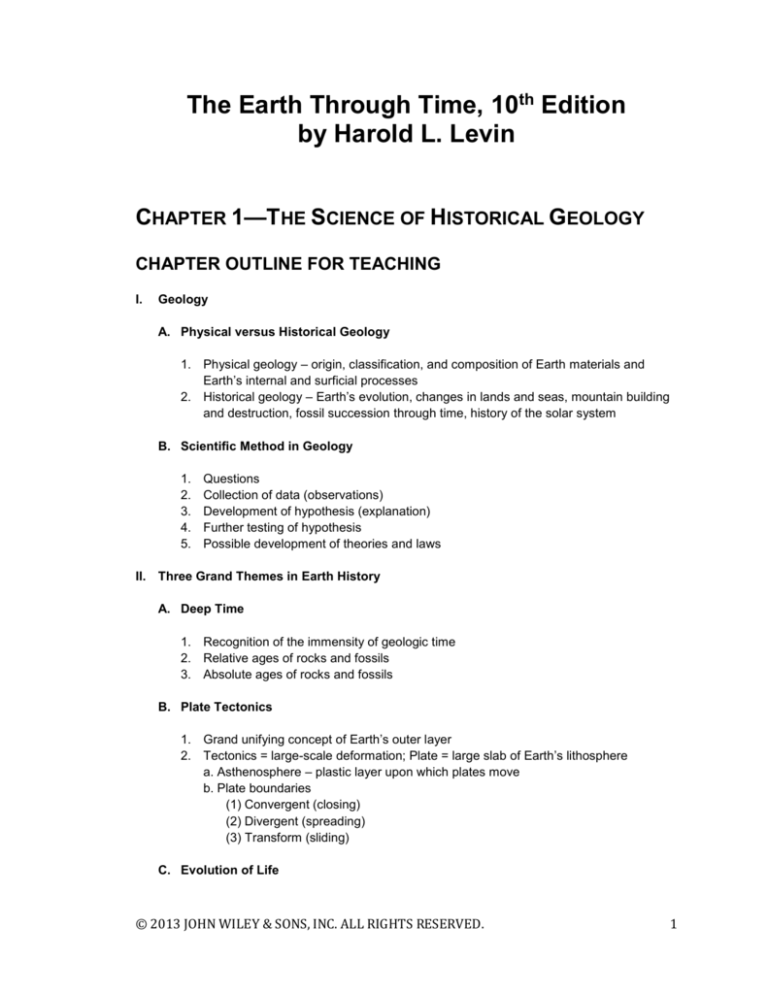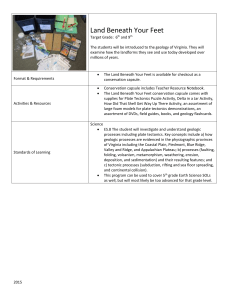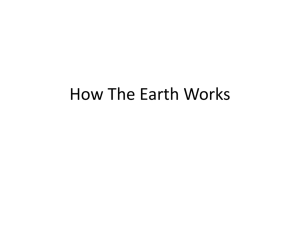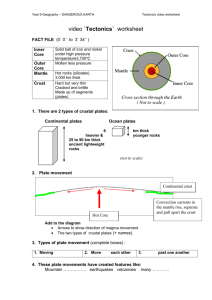
The Earth Through Time, 10th Edition
by Harold L. Levin
CHAPTER 1—THE SCIENCE OF HISTORICAL GEOLOGY
CHAPTER OUTLINE FOR TEACHING
I.
Geology
A. Physical versus Historical Geology
1. Physical geology – origin, classification, and composition of Earth materials and
Earth’s internal and surficial processes
2. Historical geology – Earth’s evolution, changes in lands and seas, mountain building
and destruction, fossil succession through time, history of the solar system
B. Scientific Method in Geology
1.
2.
3.
4.
5.
Questions
Collection of data (observations)
Development of hypothesis (explanation)
Further testing of hypothesis
Possible development of theories and laws
II. Three Grand Themes in Earth History
A. Deep Time
1. Recognition of the immensity of geologic time
2. Relative ages of rocks and fossils
3. Absolute ages of rocks and fossils
B. Plate Tectonics
1. Grand unifying concept of Earth’s outer layer
2. Tectonics = large-scale deformation; Plate = large slab of Earth’s lithosphere
a. Asthenosphere – plastic layer upon which plates move
b. Plate boundaries
(1) Convergent (closing)
(2) Divergent (spreading)
(3) Transform (sliding)
C. Evolution of Life
© 2013 JOHN WILEY & SONS, INC. ALL RIGHTS RESERVED.
1
1. Grand unifying concept in biology
2. Working mechanism: natural selection
Answers to Discussion Questions
1. When a hypothesis survives repeated challenges and is supported by accumulating favorable
evidence, it may be elevated to the status of a theory. This generally takes a long time and
requires the work of many people.
2. The lithosphere is the rigid outer layer of Earth – roughly 100 km thick – that includes the
crust as well as the uppermost part of the mantle. The crust is a part of the lithosphere, the
uppermost part.
3. Plate tectonics is the grand unifying concept that explains movement of large slabs of Earth’s
lithosphere and the effect of this movement in forming Earth’s crustal features. Divergent
boundaries are places where plates move apart. Convergent boundaries are places where
plates move together. Transform boundaries are places where plates glide past one another
without converging or diverging. Plate tectonics affects our daily lives through processes
associated with plate tectonics such as earthquakes and volcanic eruptions and their
associated local and global effects.
4. Fossils are the record of natural change (organic evolution) through time. Fossils are valuable
indicators of age of rocks and help us understand past conditions on Earth.
5. Fossils, taken from progressively younger strata, may show a detailed record of progressive
change in the structure of an organism. This is an important basis for understanding
adaptation and natural selection through time.
6. The age of the Earth is about 4.6 billion years. The oldest rocks known at the Earth’s surface
are about 4.2 billion years. It is unlikely that older rocks will be found because Earth’s earliest
history has been destroyed by the recycling of plate tectonics and the processes of rock
weathering.
7. There is strong evidence, as presented in this chapter that the Mediterranean Sea
evaporated and was refilled several million years ago. This event would have had a profound
effect upon the plant and animal species of the area, both on land nearby and in the
Mediterranean Sea. As this happened over a long time, some species may have been able to
adapt or change to the changing conditions and thus there was organic evolution.
8. Meteorites are thought to be debris from shattered planets or left over material from the
formation of the solar system. They must have formed about the same time as the Earth,
therefore their age reveals Earth’s age.
9. Events of the geologic past will eventually happen again, so a better understanding of the
cause and effects of ancient episodes of global warming may help us predict the effects of
and prepare for future global warming.
© 2013 JOHN WILEY & SONS, INC. ALL RIGHTS RESERVED.
2
10. The three grand themes are: deep time; plate tectonics; and biologic evolution.
11. The absolute age of a rock body is expressed in years. Very often, absolute ages are given in
thousands, millions, or even billions of years. This is fundamentally different from relative
ages, which refer only to the relative age order of events without reference to numbers of
years.
12. d
13. b
14. a
15. d
CHAPTER ACTIVITIES
Student activities for in-depth learning:
1. Take a look at a web page that discusses the steps of the scientific method, for example,
http://www.sciencebuddies.org/science-fair-projects/project_scientific_ method. shtml. Make note
of the steps in the scientific method and what happens when the validation of a hypothesis does
not work out. Then, consider a geological problem in the area of historical geology. Describe the
steps of the scientific method in terms of that problem. If you want ideas on possible problems for
research in historical geology, be sure to read this chapter and pick one or two other chapters in
the book and look at those for ideas. Or, you can ask your instructor for some ideas.
2. Using web pages at the University of California’s Museum of Paleontology
(http://evolution.berkeley.edu/), take a look at the concept of evolution from a paleontological
point of view. After reviewing what this web page has to offer, use the resources there to prepare
a brief summary of one of the following topics, or something very similar: What is evolution and
how does it work?; How does evolution impact my life?; What is the evidence for evolution?; or
What is the history of thought on evolution?
© 2013 JOHN WILEY & SONS, INC. ALL RIGHTS RESERVED.
3









